They live close to the last forests, for they still keep the secrets of nature. Perhaps unknown to them for centuries, the forestland and mountain ranges they inhabit contain the richest mineral reserves in the country.
Now that India is growing as an economy, development has turned its glare on tribal country.
The region that has come under the sharpest focus of the growth-rate-driven new economy is the tribal heartland of Chhattisgarh. This is a state that abounds in minerals, which in turn have brought the horde of mining companies to devour the wealth lying hidden inside the hills. Ruthless mining has left the surroundings badly scarred and the people devastated. Since the administration invariably sides with the big companies both from the private and government sectors, and the mainstream political parties are reluctant to cross swords with the corporates, the resistance has come from the far-left guerrillas. The tribals have often been caught in the crossfire between the armed forces on one hand and the plucky, at times ruthless, guerrillas on the other.
Their identity has been reduced to that of victims. But beyond it all lies their everyday life and ancestral practices, informed by science and wisdom that comes from living in close proximity to nature. They hold the key to many layers of a past otherwise lost to us. This way of life too has now come under attack from a slash-and-burn consumerist culture and the bludgeoning impact of ‘civilization’, which threatens to steamroll all individuals and social groups into a homogeneous, conformist mass, a community to be benchmarked by primetime television. To see what survives and find out about the traditions that are still extant, I visit a few villages in the districts of Kanker and Balod and meet members of the Gond tribe.
Palash flowers, or flame of the forest, whizz past our lines of vision as our motorcycles make their way from Kanker town to Khamdongdi village. Reluctant to annoy my guides as the awestruck city dweller who wants to photograph everything, I make a special request to stop at the lotus pond framed by the mountains on one side, and the blossoming plants and trees on the other. Natural beauty in the region is the rule, not the exception, so I get ready to record with my mind and eyes what I cannot click.
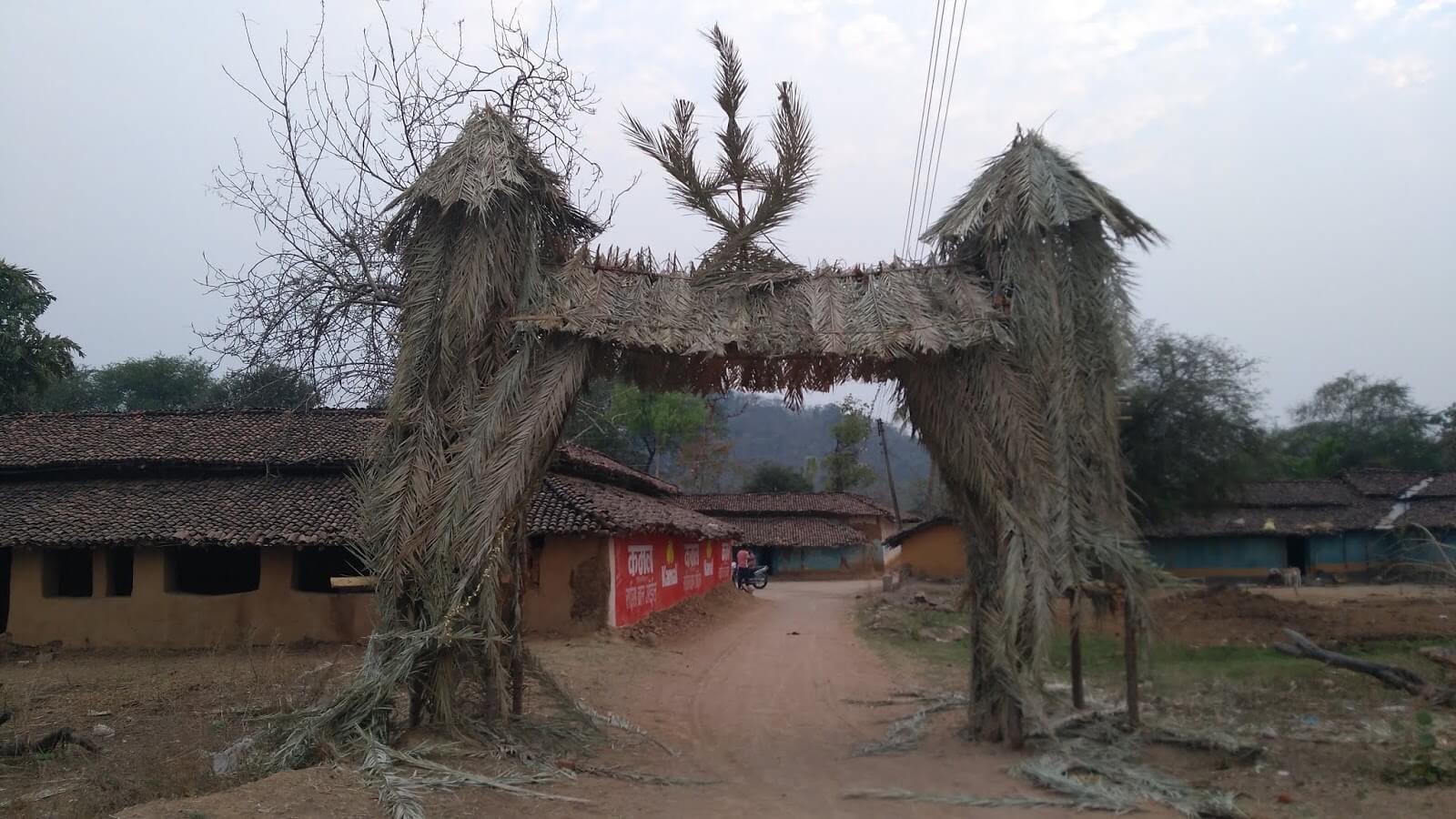
Entrance to a village
My guides are members of KBKS, Koya Bhoomkal Kranti Sena, a youth group that stands up for the right of the indigenous people and tries to understand and preserve their own culture. One of them, Yogesh Nareti, says to me, ‘At times we are not allowed to enter these jungles that you see. What has always been ours is now being claimed by the state. But so much of our life does not fit into the existing diktats and forms. We have no religion, we worship nature; yet we are being clubbed with Hindus. We don’t believe in untouchability but sometimes we are treated as untouchables. Our people are being exploited because they do not have formal education and those who get educated are buying into the majoritarian myths.’
I notice in the forest some gravestones, painted and elevated to mark the dead, a trend, I am told, that has been prevalent for the past three decades or so. Before this, huge stones used to be erected, many can still be seen about, at the burial sites, tilted in the direction of the sun to mark the time. Under some trees, I see wooden figurines suggesting it was a place of worship. But Adivasi culture has not been about idolatry, I am told. A greater, purer being is said to find refuge in trees, birds and animals, different in different communities. Each community has a few specific trees, birds, and small and big animals that they have to protect and cannot kill. This way each social group ends up protecting some flora and fauna.
The deceased are considered to have got transformed into gods who now act as the guiding lights for their descendants. Thus, the farewell, not seen as final, is celebrated. When the family members and neighbours take their dead for burial, they tell everyone around that so-and-so has ‘become a god’, not that he is dead. ‘Unmarried people are not buried with the older, married ones,’ Yogesh laughs. ‘Because we the young ones can be useless and foolish, not to be cremated with the purer, wiser ones.’ Then he shakes his head, more serious this time. ‘They used to call the burial place the gudi, the living place of our pen,the ancestral god each community has.Now they have picked up the current day parlance and call it marghat, the place of the dead. Of course when the young die it is not the same thing as the passing of an elderly person, leaving the world at the ripe age.’
With modernity pushing its way into tribal life and the pressure mounting for retaining their unique identities and getting recognized as such, some people have started adopting visible markers for their tribe. In one house, I notice a framed emblem on the wall denoting the seven seasons through that many colour stripes. The ancestors, also symbolized in some of these flags, are commemorated with gratitude because they brought up their children in harsh, at times hostile natural conditions.
The pen gudi, or the place of worship, is usually in marh, or forested areas. Since God is supposed to preserve nature – the realm they therefore inhabit – nobody is allowed to cut trees in this sacred territory. The Rowghat mines, part of the government’s development agenda in the Bastar region, became a site of contention for this reason too; it is at the heart of this pen worshipping circle. The fabled festival of lingo karsad or jatra is held here every year. Participants come from Orissa, Maharashtra and some other parts of the country. Interestingly, aboriginals from the other end of the world – as far away as the Pacific – arrive to be part of the celebrations. ‘People who come to pay their respects from other places,’ Yogesh says, ‘including the indigenous tribes of Australia and New Zealand, ask us if their wishes would be granted by the gods. We tell them they would come true for sure, but they should not be against nature or harm it in any way.’
Raj Mandavi, another KBKS member, is upset about the mines too. ‘Our puja cannot be done inside closed doors; we don’t have buildings for our gods. But when we tell the government to protect our religious areas, they say they don’t see any temples around.’ Now some educated Adivasis have started mocking the old customs, and call the followers regressive. Raj is dismissive of them: ‘They have started doing havan, imitating the Brahminical rituals.’
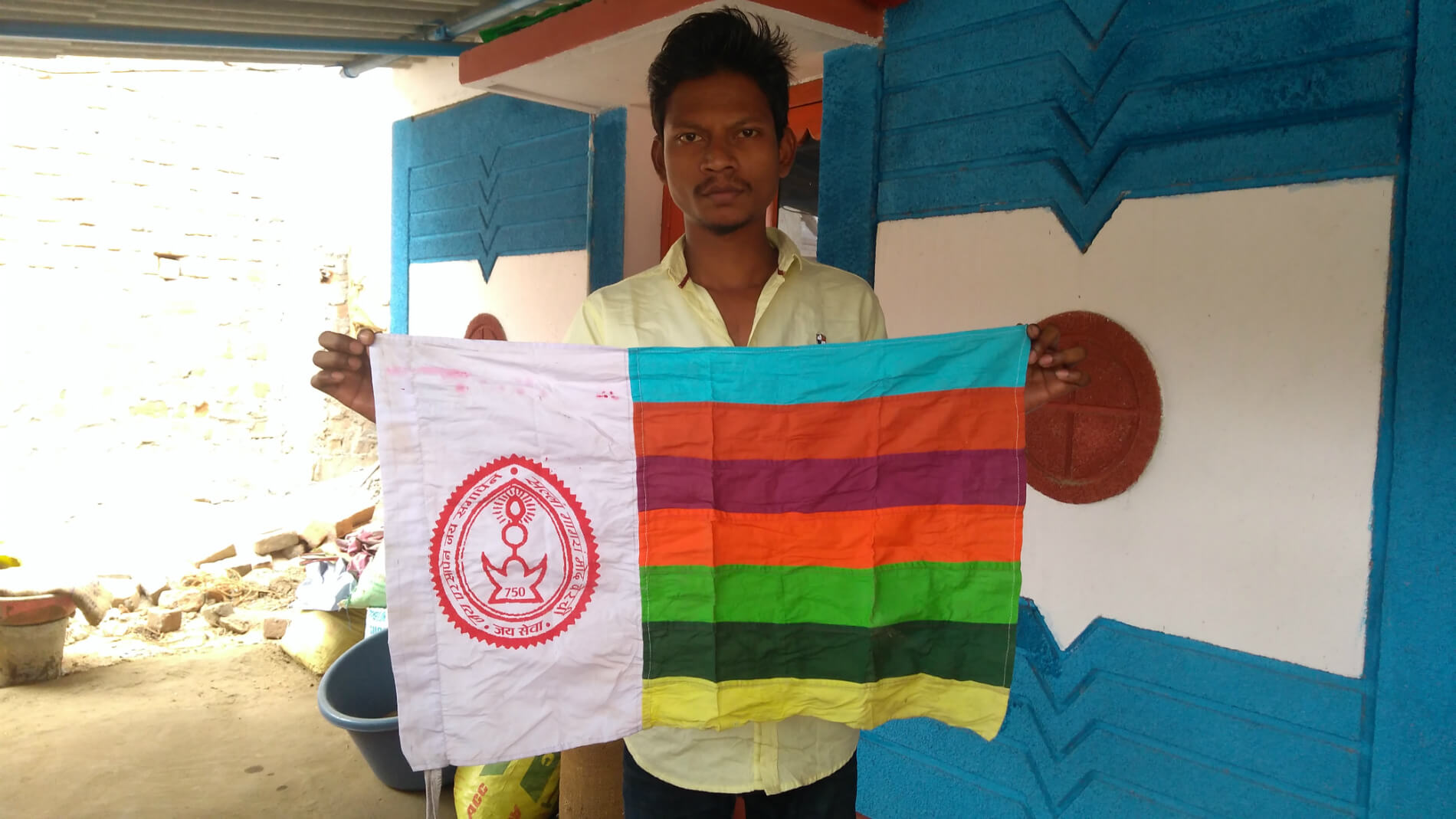
Raj Mandavi holding a flag with the symbol of the tribe
I meet Mane Singh Kavde, a herbal doctor, in Bewarti village in another part of Kanker; he draws another comparison to explain the tribes’ way with God, a highly refined form of animism that the poet Wordsworth would have appreciated. ‘If you look at how we follow the cycles of the moon, bury our dead, and so on, you would find that these ways match with the people who practice Islam.’
In the village of Vishrampuri, the youth leaders say that to them others’ caste or religion has not mattered because at the end of the day everyone around is communicating with each other using the same Gondi language.
‘We have been taught that our history begins from the time there came to be stones and rivers on this earth,’ Yogesh shares. ‘We come from water. No god has birthed us.’ He is upset that the tribes are being slotted as Hindu, and he talks of how in the official forms they are made to check the ‘Hindu’ box.
Some tribals are also borrowing from religion. On the wall of a village home in Khamdongdi is painted the ‘Om’ sign, and on the other there is a symbol marking the ancestral tribal deity Boodha Dev. A few days later, traveling in the town of Dalli-Rajhara in Balod district, in the car I listen to a song in praise of the tribal god Bada Dev. The track is a remake of the popular Hindi bhajan Om Jai Jagdish Hare. My guides are visibly embarrassed. ‘Aarti is not even a part of our customs.’
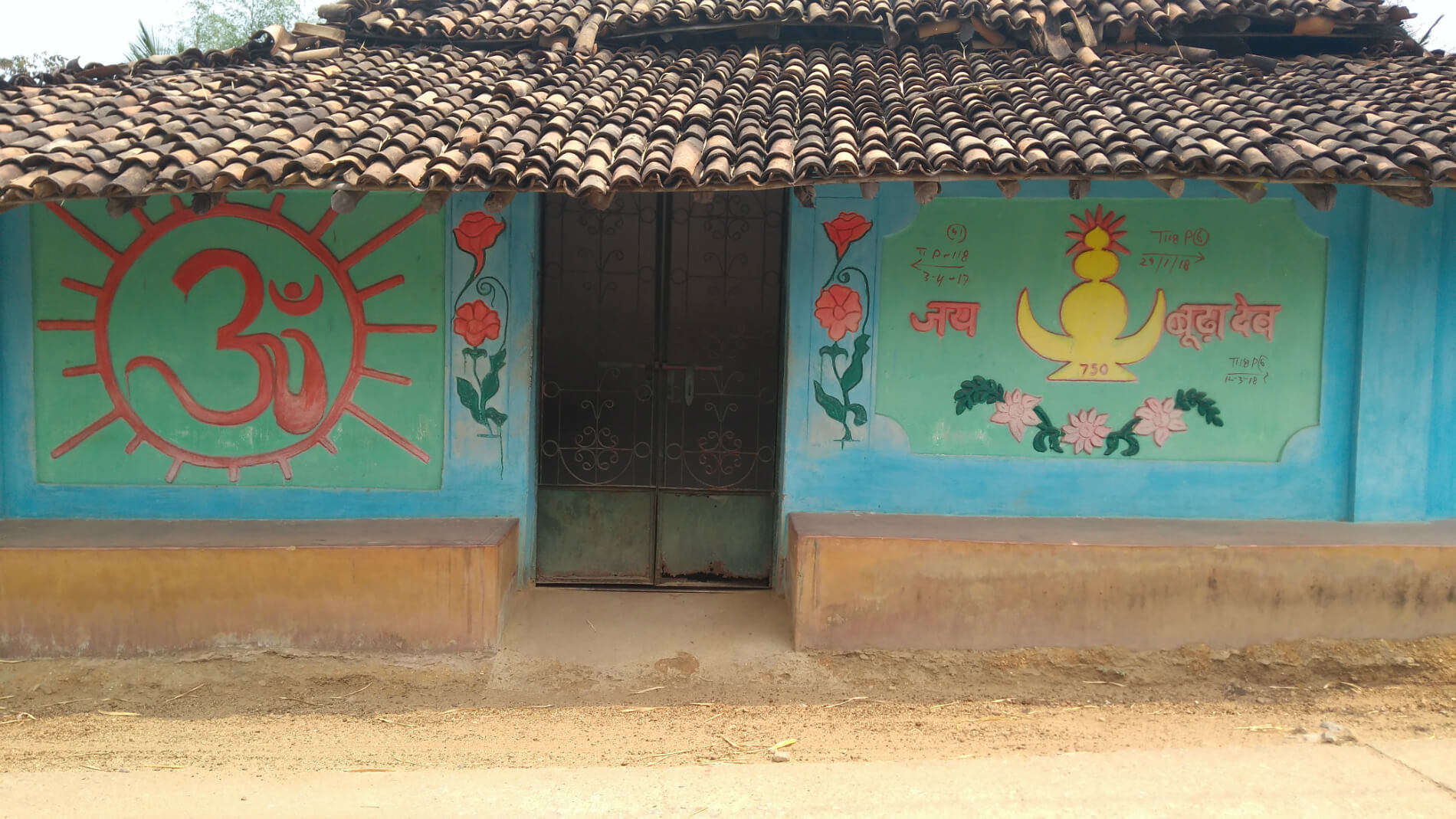
Modern religion pervades, and often gets mixed up, with the current adivasi life
To explain this, Yogesh says, ‘See, Brahmins would come to our villages and read from the Ramayana. Feudal overlords like the old zamindars had brought them in. If a person opens a big heavy book and his audience cannot follow it, he then would be called the learned man. Now some people have a problem that we don’t burn Ravana’s effigy during Dussehra; they think we don’t because we are his descendants. I mean we don’t even know who this guy is, he means nothing to us. Why should we go about setting him on fire? Our culture is scientific. But in today’s time a doctor worships a god with four hands and calls a child born with an extra limb an aberration.’
For the tribes, who have preferred the forests and mountains to multi-lane roads and swank flyovers to be true to their way of life, a change of seasons signifies a lot more than an extended Bombay Stock Exchange bull run or the crash of the blue chips. A good monsoon or the spring blossoms would impact their life in a more basic way than events that qualify for primetime breaking news.
‘Each season is so important, we actually don’t have a first,’ concludes a KBKS member after a discussion among themselves. Seven seasons, or pandum, which means to create a system, are counted following the lunar calendar: beeja (celebrating the seed); kusir (before which one is not to have leafy vegetables; garab (the paddy is pregnant and people are wishing for a good crop); punang tindana (celebrating the new harvest); charu (till this time harvesting a crop is not allowed, and certainly not chopping trees) and the second charu (the time forstoring and winnowing); hessa (offering to the pen what people would be consuming in summer – having the same in winter can make one sick); and marka pandum. The marka pandumor the mango festival signifies the ripening of the fruit, when the seed is fully formed, and the fruit can be eaten. The mango tree is supposed to put up a fight to save its children – its fruit – and therefore, it is said, eating unripe mangoes causes mouth sores. It is not surprising therefore that a traditional rela song cautions against eating the fruit in a hurry even when the time is right.
The tonda sanskar festivities mark a new birth. The tonda, or the umbilical cord of the infant, is placed in a utensil, covered and buried to preserve it and keep it safe from misuse. The namkaran or christening ceremony involves showing a diya to the child, wishing that they are always able to see. KBKS says that the elders of their communities actually retain their sight and hearing until they reach very old age; even after their eyesight weakens, their ears remain sharp.
At the time of death, there is the kunda sanskar. ‘The rites are to store the energy of those who have passed into another state,’ explains a KBKS activist, ‘through this energy, through the DNA, our ancestors will guide us.’
The most important maternal deity is tanurmutte yaya, or the first mother hen, who is believed to protect her community just as a hen keeps her brood safe by hiding them under her feathers. During the festival of dewari, which KBKS members insist must not be confused with Diwali, food is laid out in a bamboo soop,a flat-hand winnower, and the family members as well as their pets eat from it together. The activists proudly claim that hardly any ‘civilized’ community would have such respect for animals.
Talking of civilization and language, Prahlad Netam of KBKS, who has been quiet so far, says, ‘Try saying aloud ‘ya’, our term for mother. Now say ma. You will find that ‘ya’ takes much less energy, and therefore when a newborn cries it seems to be saying ‘yaya’. The Gondi language has evolved in a way that speaking takes the minimum energy. So our ancestors could live long without much eating.’ He chuckles, ‘Now we speak too much and keep getting hungry.’
When I reach Dalli-Rajhara, a small town in Balod, I am surprised to see not many people speak Gondi. In the family I visit, the elderly woman and her son converse in Hindi. But they have proudly displayed some of their tribal markers, like the calendar in Gondi script placed next to the English one and the anti-clockwise clock that moves in tune with Earth’s motion, which the tribe worships along with the moon and the sun, and other elements of nature.
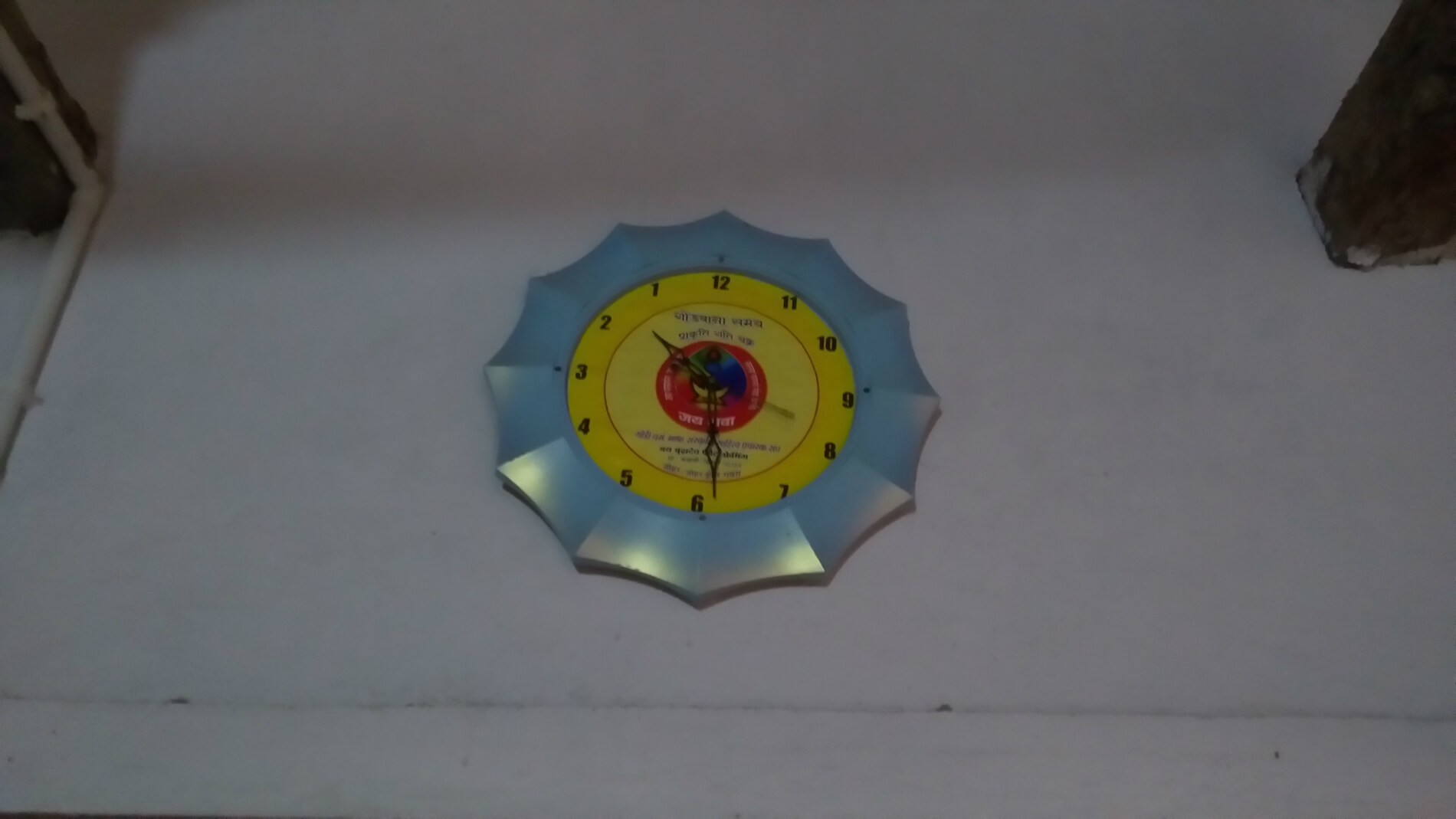
The anti-clockwise clock
Food and drinks
Having remained cut off from urbanity and development for so long, the tribal way of life has been built around the concepts of self-sustenance and barter. Food, building material, natural medicines – everything comes under it. Even today, communities located deeper into the forests like Abujmarh are largely self-reliant. The proximity to the forests gives them access to the bounties of nature. In March, when I was there, it was the season for mahua. The small flowers from the trees are used to make a drink popular among the tribal people. Romanticized by pop music and films, mahua is inseparable from any celebration in tribal country. Actually the mahua flower has many medicinal properties that make it a favorite with the herbal doctors. It is perhaps a measure of mahua’s importance in tribal culture that it is offered to the gods. The many associations of mahua are indeed mindboggling – from the toast of loud music blared across Jharkhand and Chhattisgarh, to the herbal doctor’s prescription for many ailments, to an oblation to the gods. At several places we were served it as a welcome drink.
While going for an interview, we find a mahua tree on the way. Our driver stops and steps out with my other guides to pick the mahua flowers lying on the ground. A piece of cloth is spread out on the ground, and everyone starts putting their handfuls into it. Participating in the collective act of flower picking, I notice that while the tree is laden with the blossom, nobody thinks of touching any of it, as one is only supposed to pick what the tree has dropped on its own.
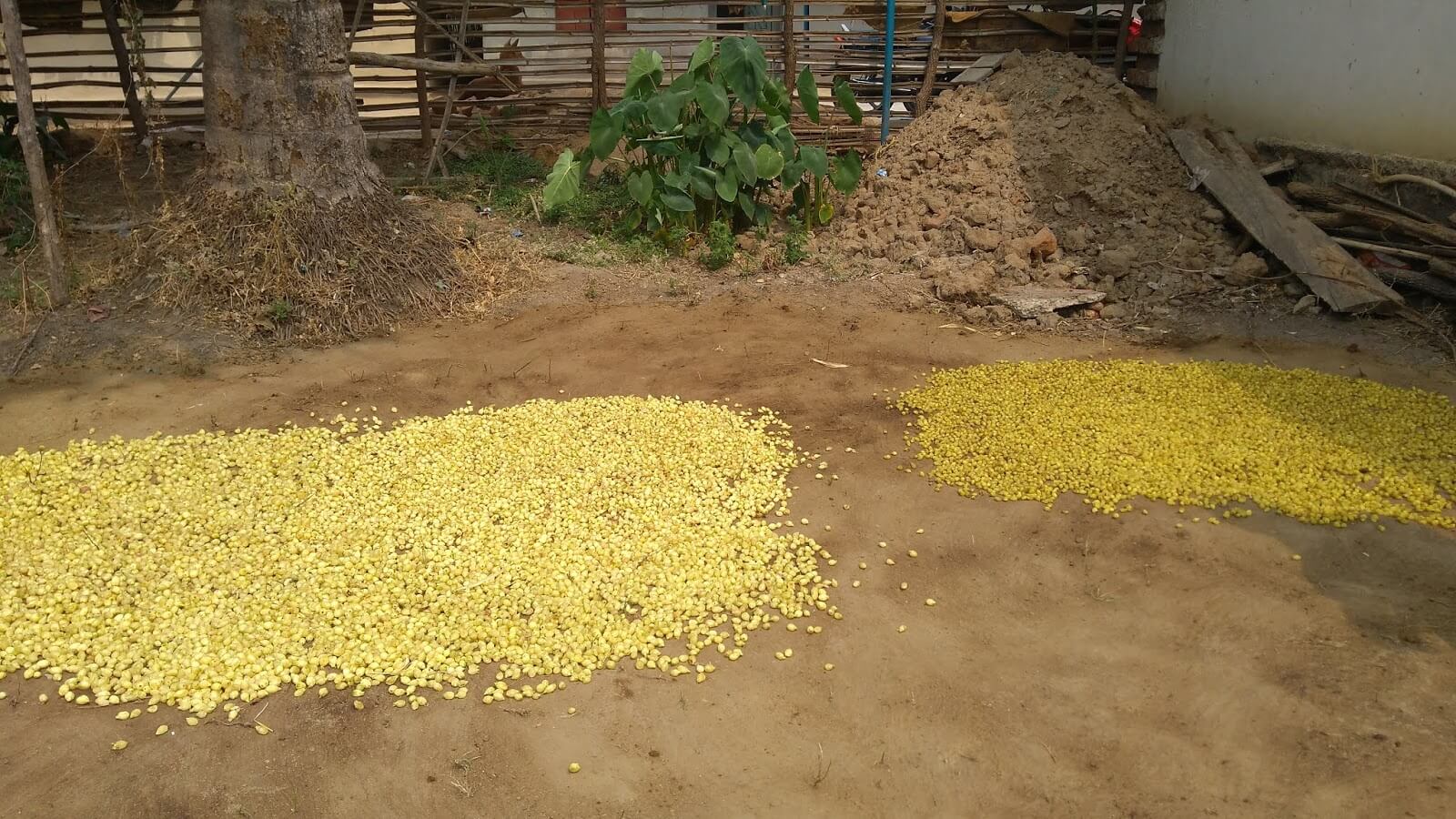
Mahua flowers being dried in the sun
Similarly, for salfi, another popular brew preferred over mahua in summer, a particular person is chosen from the community for the job of climbing up the tree to collect the juice. My guide, a young man in his twenties, talks of the beliefs that in a way maintain the order in tribal society. ‘If any of us randomly goes up and tries to get it, the juice will dry up.’ According to customs, girls are to plant the saplings, and when the drink is received from the tree the very first time, it is distributed for free to everyone around. An offering has to be made to the deity of the community the tree belongs to.
When we are invited into the house of a KBKS member, Yogesh excitedly goes inside and comes back with a soop. ‘If a young man wields this soop assertively, moving it in a way that it brings a strong gust of wind, the parents come to know he is now fit to marry. If a woman can firmly hold it on both sides and winnow, she, too, everyone around would know, has reached the marriageable age.’ This is an unencumbered way for the young people to let their parents know they have arrived. If they like someone they can make it clear to their parents, and the young man’s family will then meet the girl’s. In case there are only daughters in the house, the family goes to the boy’s family to make him their lamhaade, a son-in-law who would stay at their place taking care of the girl’s parents like his own.’
The young men talking to me contest the simplistic urban narratives, the ‘sensationalist’ media write-ups describing some festive Adivasi gatherings as the rendezvous for young men and women to hook up for the purpose of sex. KBKS sees this mindset as an attempt to belittle tribal culture. Marriages within the same gotra or clan is not allowed, (the pair must be sam-visham, or belonging to opposite gotras). But a marriage between distant cousins is not considered wrong. ‘So if you see me flirting with a woman at a rela, our community song-and-dance ritual, it is because I have known her since childhood. Both men and women sing to tease each other. We can do this only because our elders are around, and we have their sanction. If we come across the same person elsewhere, say going somewhere, our behaviour would be entirely different. We would be most respectful and see if they needed any help from us, if they had had their lunch and so on.’
More importantly, in tribal culture, women enjoy an equal status and remarkable freedom. In the days I spent there, I did not hear of dowry harassment or obsession with the male child. Tameshwar Sinha, a local journalist, explains that here a girl is valued, not considered a burden, as she is seen connecting her parents’ family to her husband’s, acting as a bridge. Among the states, Chhattisgarh significantly has the highest female-male ratio. ‘My father keeps telling me,’ Tameshwar laughs, ‘we were waiting for a girl. How come you ended up in our family?’
And what if there’s a marriage across the caste or clan injunctions? Yogesh says, ‘The rules are clear. Such a couple cannot participate in some of our most important community rituals. They will not be pressured to break up; and there is certainly no censuring them, “honour killings” do not happen here. The young people also abide by these rules and know that in these rituals they can still sit at the back, and if they have a boy, he, again, will be allowed to take part.’ But the tough part is if such a couple gives birth to daughters. Their marriage then becomes difficult. People would see this same gotra marriage as a flaw in the family line.
KBKS members resent the TV-induced urban culture seeping into village life spoiling the tribal simplicity: people now celebrate weddings under colourful marquees. ‘Earlier we would just chop some wood to erect a temporary structure and keep lending it to any family that had a wedding coming up; that way costs would be minimum.’ Relatives who came for the marming or manda sanskar, the wedding, would stay for three days. It was a time for the family to forge deeper bonds. Now everything is governed by expenses, and guests come and go even the same day. Also, while people were previously happy with silver jewellery, now, under the spell of heady consumerism, they are gold-struck. Keen to protect the tribal identity and distinct way of life, the young KBKS members are troubled by the infusion of such undesirable influences.
There is of course the ashirvad sabha, where people come to bless the couple with presents; this is called tikawan. To make sure that the host is not burdened, guests bring and contribute rice to the community kitchen. When people visit their married daughters, they follow the same practice.
xxx
Some researchers have been keen enough to understand the tribal culture by making themselves a part of it for some time and treading the complex terrain of being an observer-participant. Not very far from where I am – meeting the tribal activists and ordinary villagers nearly a hundred years ago – self-taught anthropologist-ethnologist Verrier Elwin did his seminal work among the Gonds. Much later his Tribal World of Verrier Elwin won him much acclaim and recognition. Still the loneliness of the forest people has not ended. They are either part of the tourism literature as part of the Indian exotica playing up to the cameras of the curious tourists or othered by the country’s political system. Their choices are limited: either getting exploited by a corrupt system or fetishized by the media and cultural commentators.

Indigenous Peoples are putting their bodies on the line and it's our responsibility to make sure you know why. That takes time, expertise and resources - and we're up against a constant tide of misinformation and distorted coverage. By supporting IC you're empowering the kind of journalism we need, at the moment we need it most.